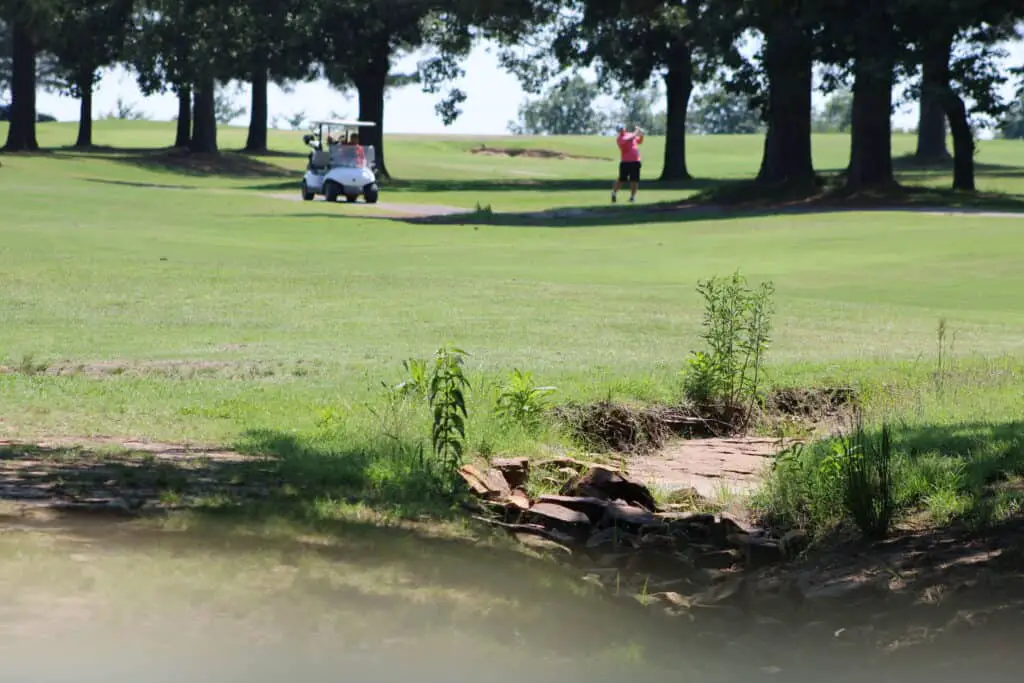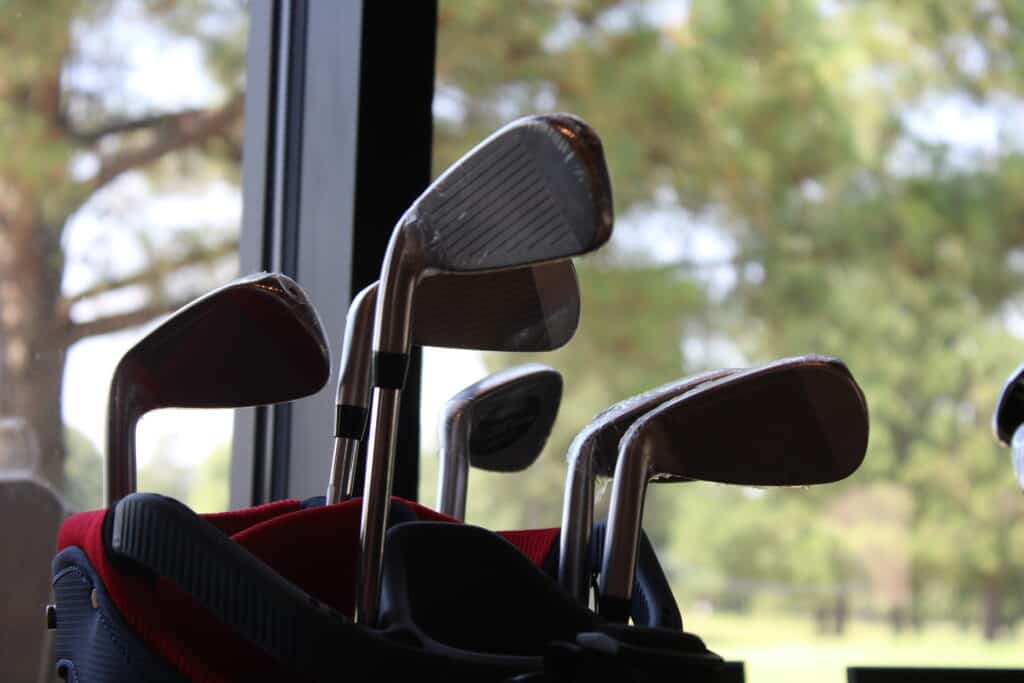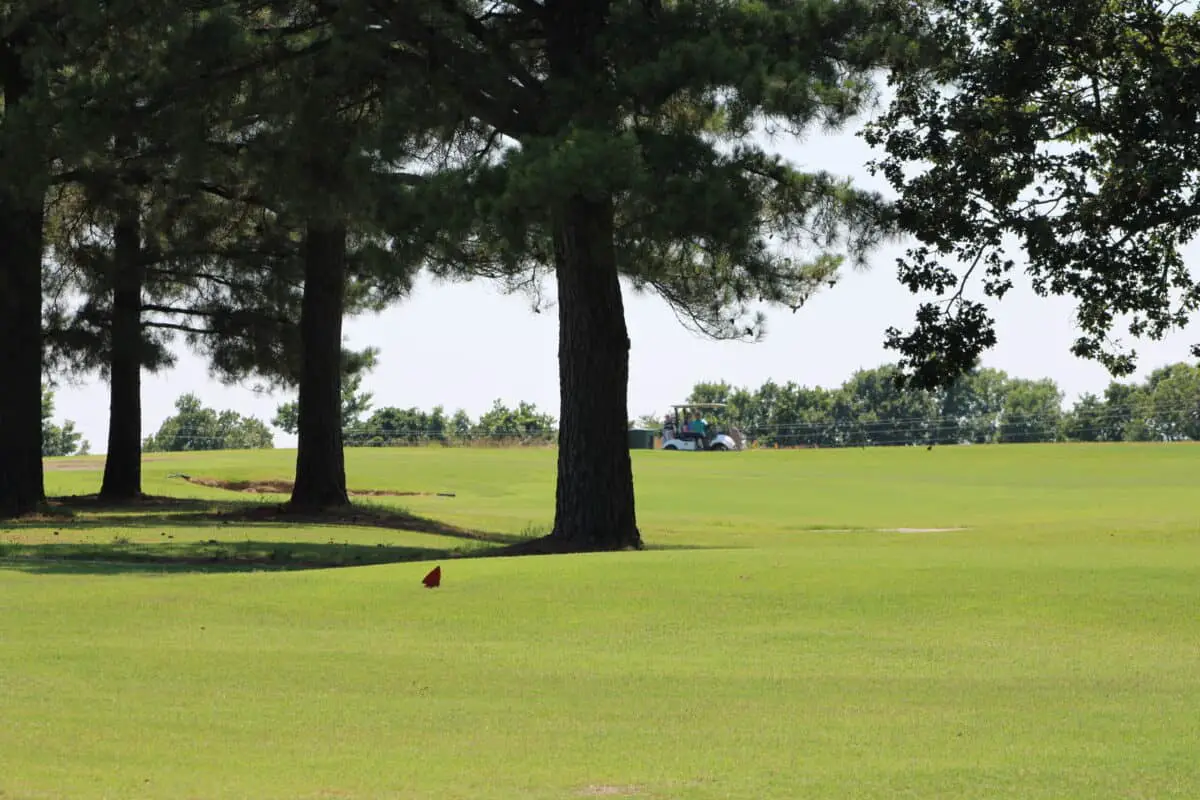As two fundamentally different clubs, the 2-iron and 3 wood don’t have much in common, and as a good ball striker, you may be tempted to carry both in your bag as they fill the loft gap and can both work from the tee if your driver isn’t behaving.
The 2-iron has around 18 degrees of loft while the 3 wood has about 15 degrees, and both can be used from the tee or fairway. The 3 wood is easier to hit and will give more height and spin, while the 2-iron will provide a lower trajectory and is an excellent option for low shots into the wind.
Let’s pull these two out of the bag and give them a thorough workout side-by-side so you can determine which of these golf clubs (if either or both) you should put into your bag for your next round on the golf course.
2 Iron Vs 3 Wood – Availability
It’s no secret that the two iron has not been a feature in most golf bags for some time now. If you wanted one, you would need to look on the used golf equipment groups on Facebook, visit your local pro-shop, see if they had any used ones lying around, or order one from your preferred club brand.

In contrast, the 3 wood is available in plentiful supply, with new and second-hand sets of fairway woods and individual golf clubs on the shelf at most pro shops and golf equipment groups online.
This contrast in availability has more to do with the fact that very few golfers can successfully and consistently hit the driving iron, and the 3 wood is easier to swing and hit.
A few manufacturers still produce a 2-iron as a player’s club or utility iron, such as Srixon, TaylorMade, and Callaway, so you can get them new if you wish. As far as three woods go, everyone makes those, so you have your choice of brands on that one.
Golf Clubs Loft, Shaft Length, And Distance
In the 70s, the two iron was the lowest lofted club in the golf set and was used as a driving iron or utility club to play those low-stinging shots into the wind. It was not uncommon to see players of that era hit these clubs off the tee either, as their downward trajectory and low spin gave them plenty of distance.
In the modern game, the 2 iron is a rarity with fewer professional golfers carrying them in their bag, as the fairway woods and hybrids have taken the place of the long irons.
Between 16 and 19 degrees of loft, the two iron would be the equivalent of the modern five wood in terms of loft but would have delivered a ball flight than the five wood.
The modern 3 wood has a loft between 15 and 18 degrees and some as low as 13 or 14 degrees of loft for that extra distance, whether required from the tee or fairway. You can see that the 3 wood has a lower loft on average.
Golf Club Lengths
If you consider that the average 3 wood has a shaft length of around 42″ and the two iron has a shaft length of approximately 40″, the 3 wood is a longer club to swing and, in terms of length, is the next longest club in the bag, with the driver being the longest.
This longer shaft on the 3 wood helps create the distance gap between the 3 wood and the 2 iron. That shaft length along with the loft on the club result in different ball speed when struck. This is true for high handicappers, the average golfer and professional players.
Fairway Woods vs Irons – Distance
Here, the 3 wood wins, and even though Tiger’s 275 yards 2 iron at the 1999 Memorial remains etched in 2 Iron and golf history, the average player would struggle to hit a driver that far, never mind a driving iron- but then Tiger certainly was no average player by any means!

If you compare the 3 wood, five wood, and two iron in terms of distance for the average length hitter, the two iron will finish lowest in that race, with around 190 yards, while the five wood at about 200 yards and the 3 wood first at 210 yards.
One of the reasons for this, which we will look at in a little more detail, is the difficulty in swinging and striking the ball in the sweet spot with the two iron, resulting in shorter distances and inconsistency.
2 Iron Vs. 3 Fairway Wood Pro Distances
Some of the longer hitters on tour can carry more than 230 yards with a 3 wood, which would be the average distance for an amateur golfer with a driver. Tiger’s Taylormade M5 3 wood carries about 265, just to put that in perspective, Bryson can carry that 3 wood to about 295!
If you look at Dustin Johnson’s distances with his M1 3 wood and UDI 2 Iron, he can achieve around 280 yards with the 3 wood and about 260 yards with the utility iron.
With these kinds of results, you would think that more pros would carry the 2-iron in their bags, but this is not the case, and there is an excellent reason for it.
2 Iron Vs. 3 Wood – Which Is Easier To Hit Consistently
You will know that question if you have ever tried to hit a 2-iron and then switched to a 3 wood. The two iron is notoriously difficult to hit well, while the 3 woods are consistently easier.
This is due mainly to the clubs’ design regarding forgiveness and sweet spot size. The two iron is the mother-in-law club and has little forgiveness for any off-center strike and doesn’t care if you’re a pro or weekend player.
It demands high swing speed and accuracy of the strike to smile for you- anything less, you will be punished. If you don’t have a consistent swing speed of more than 100mph-105mph on your driver, you will struggle to hit the driving iron.
Having a higher swing speed does not automatically mean you can hit a driving iron consistently well. This club has a relatively small sweet spot, and poor strikes will cost you the distance.
By comparison, the 3 wood is much easier to hit, has a more prominent sweet spot, and offers more forgiveness on imperfect strikes, with a lower loss of distance if it doesn’t come out of the middle.
Why Don’t More Pros Use The Driving Iron
If you want to be good at the game of golf, you need to be a good golf ball striker, and if you’re going to play professionally, you need to be a great ball striker. We would all agree that the pro golfers are all great ball strikers, but why don’t more of them use the driving irons?
In a pressure situation, you will pull golf clubs from your bag that you have tremendous confidence in, especially when the chips are down and you have to make your shots count.
To make a 210 or 220-yard shot over water, would you instead pull a club that you are 60% confident with or one you are 80% satisfied with?
Many modern pros use cavity back or muscle-back irons in the bags as they have that little extra forgiveness, and in this game, even the best need a little now and again. As we saw with the advent and rise in popularity of the game improvement irons in the late 90s, the pros will look for every advantage and reduce risk.
Modern fairway wood has more forgiveness than the traditional driving irons. Even though modern two irons are made with the same precision and some forgiveness compared with traditional ones, this club’s distance is eclipsed by the fairway woods and hybrid golf clubs available.
In short, the versatile golf club (hybrid golf clubs) and woods that deliver the same results in distance and consistency are easier to hit. Period.
Off The Tee Box
We see it on TV where the pros will take a 3 wood off the tee where the fairway is tight, or their driver is not playing well. While the two iron would give a little more control on the shot in terms of shaping, the pros are good enough to shape and control the 3 wood and achieve more distance.
While the 3 wood doesn’t have the same versatility as a driving iron, and it is easier to hit those low trajectory shots into the wind without compromising distances due to lesser height and spin, pro golfers often have other clubs in their bag that can offer the same results.
Which Do You Choose
As for choosing which club to put in your bag, consider your swing speed and ball-striking ability and be honest about it. You only have 14 clubs, so pick the ones that are best suited for your game and skill level.
Average Players And Beginners
If you have a slower to medium swing speed, creating medium ball speed, then a two-iron is not an option, as you won’t get it off the ground. Three woods are a much better option as you will have better results, especially where you have matched the shaft flex to your swing speed.
Even though you could match a two-iron shaft to your game, the smaller sweet spot would require a higher degree of swing accuracy, and unless you are playing off a single-figure handicap, the 3 wood will be a better option.
The two iron is not even on the table for a beginner, and a novice would be better off considering the hybrid options for the longer clubs rather than the 3 wood. This choice will build ball-striking confidence during the first few months or first year, and once that has developed, then a 3 wood in place of a low lofted hybrid golf club could well be an option.
Single Figure Handicaps
If your iron striking is good at this game level, then a two-iron in your bag may well be an option. Remember that you will get more control over your shots with iron, and modern two irons benefit from improved technology in their design and performance.
IF you find that your five wood gives you too much height or spin and you want something that provides more distance and lower trajectory, then adding the two iron is undoubtedly on.
King Cobra, TaylorMade, Callaway, and Titleist offer some great two irons, so test out a few and see which one delivers better shot results.
The additional versatility of the driving iron for punching shots out of trouble from under low trees and similar hazards, especially where your golf course has that kind of layout, makes the 2 iron a firm consideration.
The Hybrid Factor
Pros and amateurs alike have only 14 clubs to choose from and will opt for a club range that will cover the lofts and distances on the longer clubs and ones that are easier to achieve consistent quality striking with.
The reality of golf in this day and age is that most of the world’s golfers are playing at 16 handicaps or higher, which precludes many from even considering using a two-iron in their bags.
Even the 3 wood golf club has come under pressure with the emergence of a wide range of hybrid clubs that can deliver the same distance with lofts between 14 and 17 degrees.
These low lofted hybrids make those long shots much more manageable, and for golfers that simply want distance from a club and the opportunity to make good contact and achieve consistent results, the 3 wood wins out over the two iron.
How many golfing buddies do you know that even own a two-iron, never mind play with one? Most golfers you meet or play with have a complete set of fairway woods, and if they don’t have a 3 wood, they often do have the five wood, which is the natural replacement for the 2 iron.
Conclusion
The 2 iron golf club and three fairway wood offer the golfer different options in terms of distance and shaping. Still, the 2 iron are more suited to players with higher swing speed (and thus higher ball speed) and are solid iron strikers, while the 3 wood generally holds more flavor due to its greater forgiveness and more prominent sweet spot.
The best way for you to determine whether you want one, both, or none in your bag is to go and test them in various brands and models. Then, see which one works better for your game on the actual golf courses, there is no right and wrong, as only the number on the card at the end of the round matters.
- Should Tee Boxes Be Level? - January 23, 2024
- 3 Hybrid Distance - November 15, 2023
- Innovations in Golf Mobility: An In-depth Review of Top Golf Scooters - October 12, 2023
